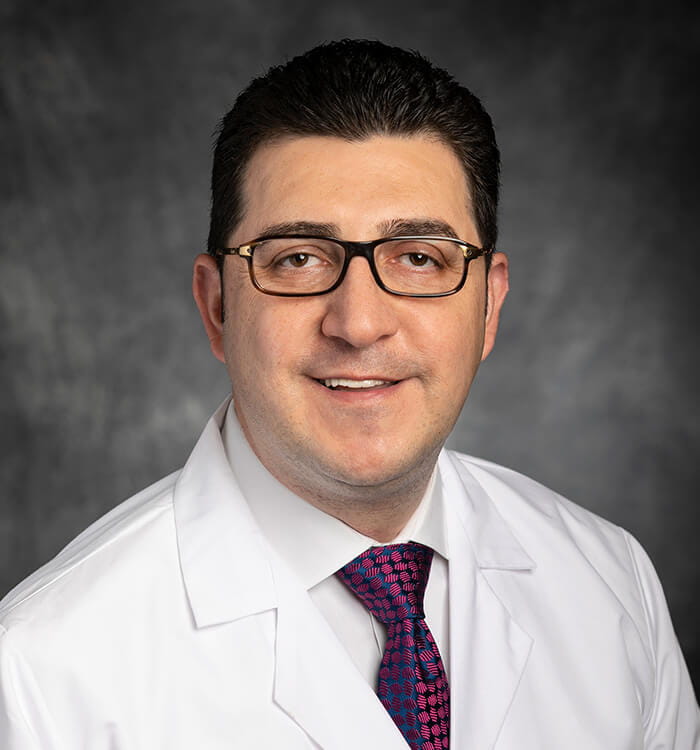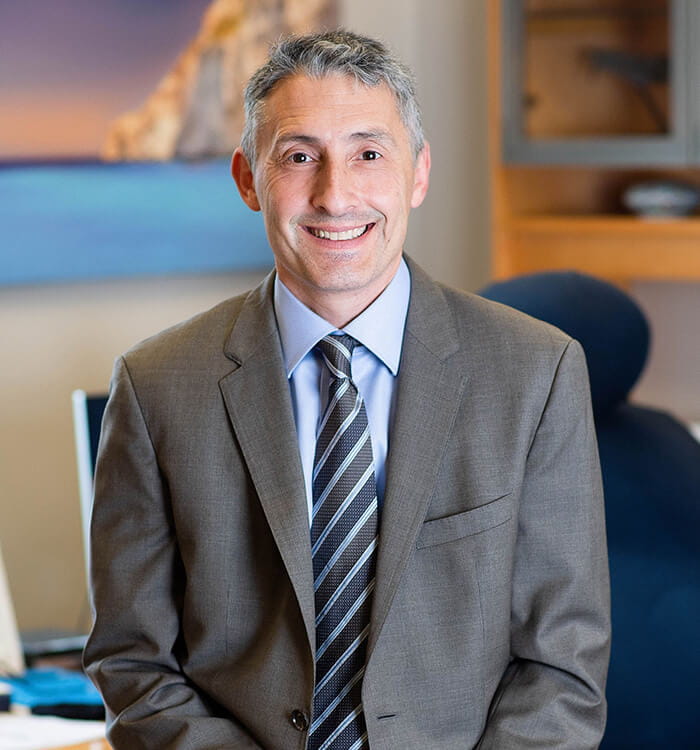International Study of Endovascular Thrombectomy Demonstrates Improved Functional Outcomes in Large Ischemic Stroke
July 03, 2023
Innovations in Neurology & Neurosurgery | Summer 2023
A groundbreaking international study of endovascular thrombectomy (EVT) in patients experiencing large ischemic stroke was recently published in the New England Journal of Medicine to coincide with its presentation at the American Heart Association’s International Stroke Conference 2023. Funded through a grant from Stryker Neurovascular, the SELECT2 Trial was led by University Hospitals Cleveland Medical Center in collaboration with the University of Texas Houston McGovern Medical School.
 Amrou Sarraj, MD
Amrou Sarraj, MD Nicholas Bambakidis, MD
Nicholas Bambakidis, MD“The results showed compelling evidence for the safety and efficacy of EVT in patients presenting with extensive ischemic changes on CT or large core volume on perfusion imaging,” says Amrou Sarraj, MD, the Global Principal Investigator and Lead Author of the study. “The findings challenge the current paradigm of standard medical care and open the door for an additional 20 to 25 percent of stroke patients who have previously been deemed too high-risk for the procedure.”
Dr. Sarraj is the Director of the Cerebrovascular Center and Comprehensive Stroke Center at University Hospitals, Director of Stroke Systems and the George M. Humphrey II Chair in Neurology at University Hospitals Neurological Institute. “Historically, the outcomes for this patient population have been ominous, leaving most individuals bedridden, wheelchair-bound or dead,” he says. “We can already see the impact of these findings, with many hospitals and the American Heart Association working on updating their guidelines. Thrombectomy is a powerful treatment that improves functional outcomes and saves lives.”
The SELECT2 Trial represents a continuation of University Hospital’s legacy of advancing stroke research and treatment. “Thirty years ago, the UH stroke team was one of the first in the country to perform thrombectomy procedures for acute major stroke. We have developed innovative neuroimaging protocols to select patients who could benefit from such interventions and contributed to clinical trials that pushed the envelope from six hours out to 24 hours after the onset of stroke symptoms,” says Cathy Sila, MD, Chair of the Department of Neurology at University Hospitals and the Gilbert W. Humphrey Professor of Neurology at Case Western Reserve University School of Medicine. “The success of the trial is a testament to the dedication and perseverance of Dr. Sarraj, the UH stroke team and his collaborating coinvestigators across the world. We are proud to be leading the charge toward a brighter future for patients and their families affected by stroke.”
Participating institutions included 31 medical centers throughout North America, Europe, Australia and New Zealand. The randomized, open-label trial had an original target of 560 patients. Researchers assigned 178 patients to EVT plus standard medical management and 174 to medical management alone before the Data and Safety Monitoring Board halted the trial due to the documented overwhelmingly superior outcomes of thrombectomy. Nearly 20 percent of patients in the EVT group achieved functional independence, compared to 7 percent in the medical management group. While cerebral hemorrhages were infrequent in both groups, EVT was associated with vascular complications. Mortality was similar in the two groups.
“The Neurological Institute at UH is a leader in clinical trials involving patients with stroke. This study led by our researchers will dramatically improve the treatment of patients, not just in Northeast Ohio, but worldwide,” says Nicholas C. Bambakidis, MD, Chair of the Department of Neurological Surgery, Director and Vice President of the University Hospitals Neurological Institute.
In May, Dr. Sarraj and his coinvestigators presented further study findings at the European Stroke Conference in Munich, Germany, evaluating the outcomes and thrombectomy treatment effect in key clinical and imaging subgroup populations. “It takes a tremendous amount of work to design a study and implement it on four continents, but I told my steering committee and co-investigators that I never felt I was by myself,” he says. “Many people contributed to answering this vital question that will change the future of stroke management. The ability to offer EVT for large strokes is a significant shift that will bring hope for meaningful recovery to patients and their families.”
For more information, call Amrou Sarraj, MD, at 800-552-8338.
Contributing Experts:
Amrou Sarraj, MD
Director, Stroke Systems
University Hospitals Neurological Institute
Director, Cerebrovascular Center and Comprehensive Stroke Center
George M Humphrey II Endowed Chair of Neurology
University Hospitals Cleveland Medical Center
Professor of Neurology
Case Western Reserve University School of Medicine
Nicholas C. Bambakidis, MD
Vice President and Director
University Hospitals Neurological Institute
University Hospitals Cleveland Medical Center
Harvey Huntington Brown, Jr. Professor and Chair in Neurosurgery
Case Western Reserve University School of Medicine


